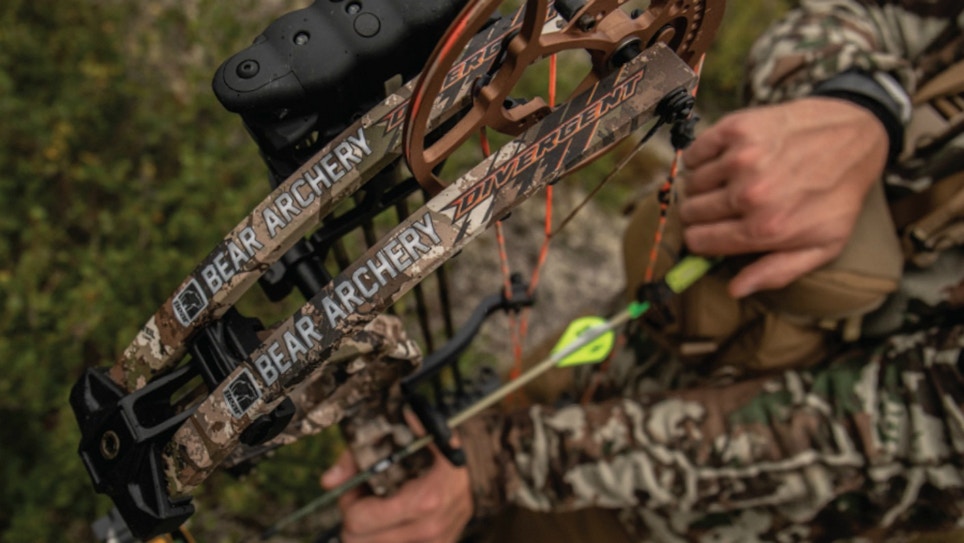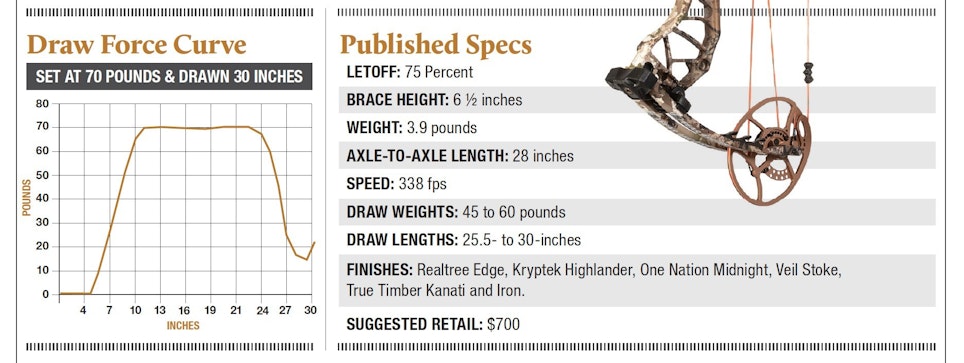Flagship bows tend to get all the attention. Bear’s 2019 Divergent might be an exception — and not just because this aptly named bow isn’t even recognizable at a glance as a Bear bow. It’s also super compact at 28 inches. We can expect to see more super compact bows thanks to a recent relaxation of Pope and Young policies regarding bow length. A weight of 3.9 pounds puts it close to some of the lighter carbon bows in that category. Finally, the moderate $700 price tag gains some attention for the Divergent, as well.
Despite the different — for Bear — appearance, thanks largely to the riser design, the compact length and possibly some new camo patterns as well, the Divergent does include some standard Bear design features. The Beartrap limb pockets will look familiar to any Bear aficionado — as will the Narogrip, the string stop and the cable guard. These are all proven Bear technologies and in fact employment of some of these features, such as the standard cable guard as opposed to the roller guard found on Bear’s flagship Kuma and the Narogrip as opposed to the grip options of the flagship bow, are what help to keep the cost affordable while offering the kind of performance Bear shooters have come to expect from Bear in recent years.
Bear shooters like a draw length adjustable without changing cams, purchasing new modules or even pressing the bow. And while that option may mean a slight compromise in efficiency, it offers some real advantages to most shooters. For one thing, it’s not unusual at all for less experienced shooters to change their draw length over time as their shooting form improves. Even among experienced shooters, changing from one wrist caliper release to another with a more trigger-forward design, for instance, can change your anchor point. That effect can be even more pronounced if you change from a wrist caliper release to a thumb release. Changing your anchor point is not normally a good thing. What you can do instead is lengthen the draw length of your bow while maintaining the same anchor point. What’s so good about that? It’s free speed. A one-inch increase in draw length achieves up to 10 fps in additional speed. By switching release aids, shortening their D loops, or adjusting to trigger the release at the first joint of the finger instead of with the tip (which is more correct in any case) some shooters can easily add two inches or more to their bow’s draw length, which is 20 fps or more in speed that requires no additional effort and costs nothing. Absent adjustable draw length, experimenting with these changes is difficult, expensive, and time consuming.
Earlier, I referenced that the Divergent is not as instantly as recognizable as a Bear bow as are most other offerings from Bear. That is not to suggest that it’s not a good-looking bow. In fact, subjective as this may be, it’s one great looking little bow. Long riser bows with skinny brace heights have their advantages, but good looks aren’t among them. I know, bowhunters aren’t supposed to care about looks. In addition to the compact length, the new camo patterns enhance the appearance as well. The test model came in Veil Stoke and with copper-colored cams, contrasting orange and tan strings and understated logos, the Divergent is among the better-looking bows out there. And though it’s not a flagship model, I found no flaws in fit and finish, and no machining marks of any kind. In terms of durability, it passed the scratch test.
Shooting the Bear Divergent
I can’t recall ever having difficulty setting up a Bear bow. Out of the box it was slightly above 70 pounds, and set for a 29-inch draw length, so I adjusted these to 70 pounds even and 30 inches. Our standard test accessories mounted smoothly and without difficulty, and the rest was quickly tuned by adjusting it so that arrow shafts held against the inside of the riser and against the shaft were parallel with the shaft on the rest. This works with Bear bows, but not with others. This put me close to bullet holes in paper with an unfletched arrow and a few tweaks got me the rest of the way.
If you like light bows, lifting this one will bring a smile to your face. Compact bows tend to also be better balanced. The grip is not exceptional, but it is comfortable. The draw force climbs pretty quickly — which is a good thing — and stays there a while to boost speed before breaking over smoothly to full draw. The Divergent employs cable stops, not limb stops. The popular trend seems to be toward the absolute rigidity of limb stops; personally, I feel that I tend to draw through the shot more consistently with the firm but slightly softer feel of cable stops. At the shot, there is a detectable but insignificant vibration, but the bow is quieter than I would have expected for a bow this light.
As Bear expands its line-up to offer bows appealing to a wider range of preferences, the Divergent fills an important niche. If your preferences run to shooting javelinas at 80 yards, you can probably find a bow that is more forgiving at longer ranges. But if you’re among the whitetail hunters at whom this bow is marketed and you like light, compact bows, you’ll be hard pressed to find a bow that matches the Divergent in this price range.
For more information, visit www.beararchery.com.
How We Test
- Each bow is carefully inspected out of the box for fit and finish and for any visible defects in workmanship. Axle-to-axle length, brace height, mass weight and draw length are measured and compared with stated specs. Minor discrepancies in draw length are corrected or noted.
- A QAD UltraRest is installed, and each bow is equipped with a TruGlo sight, a TruGlo stabilizer, a G5 .25-inch Metapeep and a D-loop. Test arrows are Carbon Express Maxima Red arrows at weights of 385 and 440 grains, fletched with Bohning Blazer vanes and fitted with QAD Tune-A-Nocks. Peak draw weight is established, and draw force curves, along with letoff, are determined using an Easton Bow Force Mapping System.
- Using a Spot-Hogg Hooter Shooter bow-shooting machine and a ProChrono chronograph, arrow speed and kinetic energy are measured at point of launch and at 20 yards. Sound is measured with an NM102 Sound Level Meter with mic positioned 3 feet in front of the bow and 18 inches under the arrow flight path. All bows are pressed on a Buckeye Archery Solutions Bow-A-Constrictor press.









